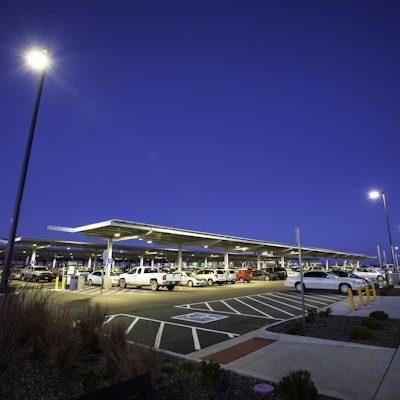
Brannan Sand & Gravel Co., Denver, CO, was the key paving subcontractor in an award-winning park-and-ride parking lot serving the Denver International Airport.
Completed between May 2015 and April 2017, the 61st and Pena Station Parking Facility was honored for Best Design/Implementation of a Surface Parking Facility in the International Parking Institute’s (IPI) 2018 International Parking Design Competition.
Brannan Sand & Gravel was a subcontractor hired by the general contractor Hensel Phelps, Greeley, CO, to pave access roads and a 29,000-sq.-ft. parking lot. Parking lot paving was to be 6,600 tons of 6-inch thick full-depth paving placed in a 4-inch lift and a 2-inch lift.
“In this area we do a lot of full-depth asphalt paving with no base material and that was the plan here,” says John Trinder, estimator and project manager for Brannan Sand & Gravel.
Why to Proof Roll
Paving of the award-winning parking lot was scheduled to start in February 2016, but once begun Brannan had to stop because the underlying water table was so high.
“That was the only real problem on the job. We couldn’t pass any proof rolls,” Trinder says.
So Hensel Phelps brought in a stabilization contractor to firm up the subgrade by mixing 4 percent cement to the existing subgrade. The process took about a month.
“They had to increase that in some areas because we were still experiencing failures on proof rolls,” Trinder says.
He says that sometimes stabilization can add enough strength to the subgrade that contractors can reduce the thickness of the asphalt, but in the case of the parking lot they opted to stay with the 6-inch depth originally planned.
“Sometimes when we have to stabilize the subgrade that adds some structural value to the subgrade, but we didn’t think it added enough in this case so we stayed with the 6-inch depth originally bid.”
But he says that because they realized early in the job that the subgrade needed to be stabilized, the GC also had all the access roads stabilized.
“In the case of the roads, they were able to add enough cement to improve the structure of the subgrade, and because they added some structure we were able to reduce the depth of the asphalt from 10 ½ to 9 inches, which helped bring the project in line with the original budget,” Trinder says.
Change Order Challenge
Before they got restarted on paving Brannan Sand & Gravel received a change order that the developer wanted to add solar panels throughout the lot and they wanted to know if that would change the price.
“They wanted us to do all the paving around the light poles after they were installed,” Trinder says. “While there were already a few islands and light poles in the parking lot area there were few other encumbrances so this would have made paving more difficult and slower and would have changed the price drastically.”
After discussions, the developer, the GC and the contractor decided Brannan would pave the first 4 inches as planned, then the general contractor would install the caissons for the solar panels. Brannan would pave the final 2 inches around the caissons, even though it would slow the work because of the handwork required.
Trinder says the lot was so wide open for paving the 4-inch bottom layer they used two paving crews, working from opposite sides and meeting in the middle.
He says they often use two crews on a paving job when they have an extra crew available and when the job warrants it. He says they typically run five 7-person paving crews in peak season and even though this was early in the season and not all five crews had been brought in, work was slow so the second crew was available.
“We are just getting our crews back in March and April but we luckily had a second crew available,” he says. “Without the second crew it would have taken four or five days to pave that first 4 inches.”
He says paving the 4-inch lift went smoothly, the only challenge being coordinating the trucking as the two crews got closer to finishing in the center.“But we have good communication on our jobsites and that enabled us to finish the first level without any issues,” Trinder says.
He says crews paved 2,150 tons the first day and 2,870 tons the second day.
After they paved the bottom 4-in. lift the GC came in and drilled and placed all the concrete caissons for the solar power panels. Brannan finished paving the 4-inch lift in April 2016 and returned for four days at the end of October to compete the paving the top 2-in. lift.
Trinder says they used only one paver for the top 2-inch lift. The operator maneuvered the paver smoothly through the lot, opening and shutting the wings as needed.
The only changes in their paving plans was adding a skid steer to bring mix to areas around the caissons the paver couldn’t reach and adding an extra laborer to help with the additional hand work around the caissons.

















![Lee Boy Facility 2025 17 Use[16]](https://p1-cms-assets.imgix.net/mindful/acbm/workspaces/default/uploads/2025/09/leeboy-facility-2025-17-use16.AbONDzEzbV.jpg?ar=16%3A9&auto=format%2Ccompress&fit=crop&h=135&q=70&w=240)


